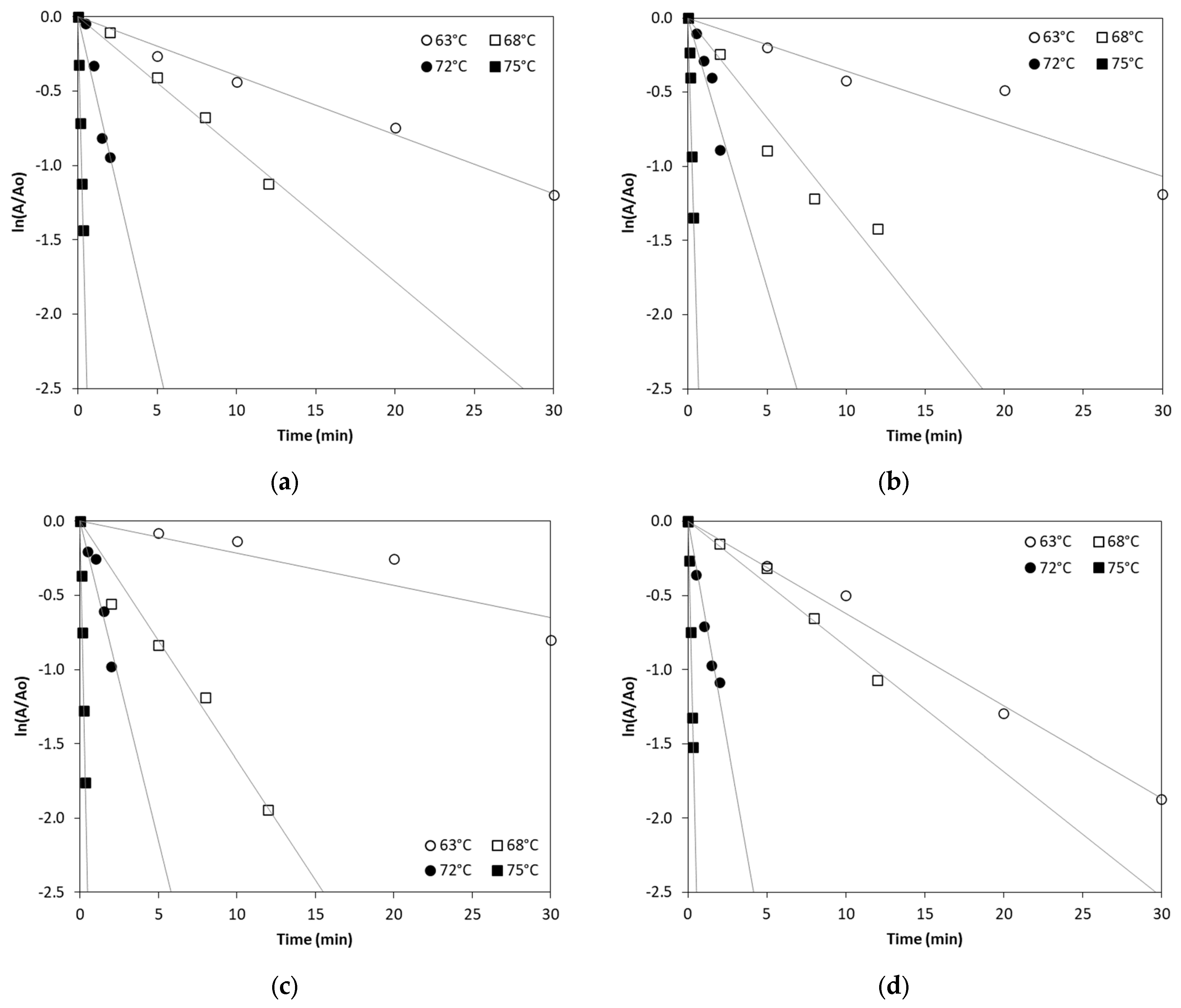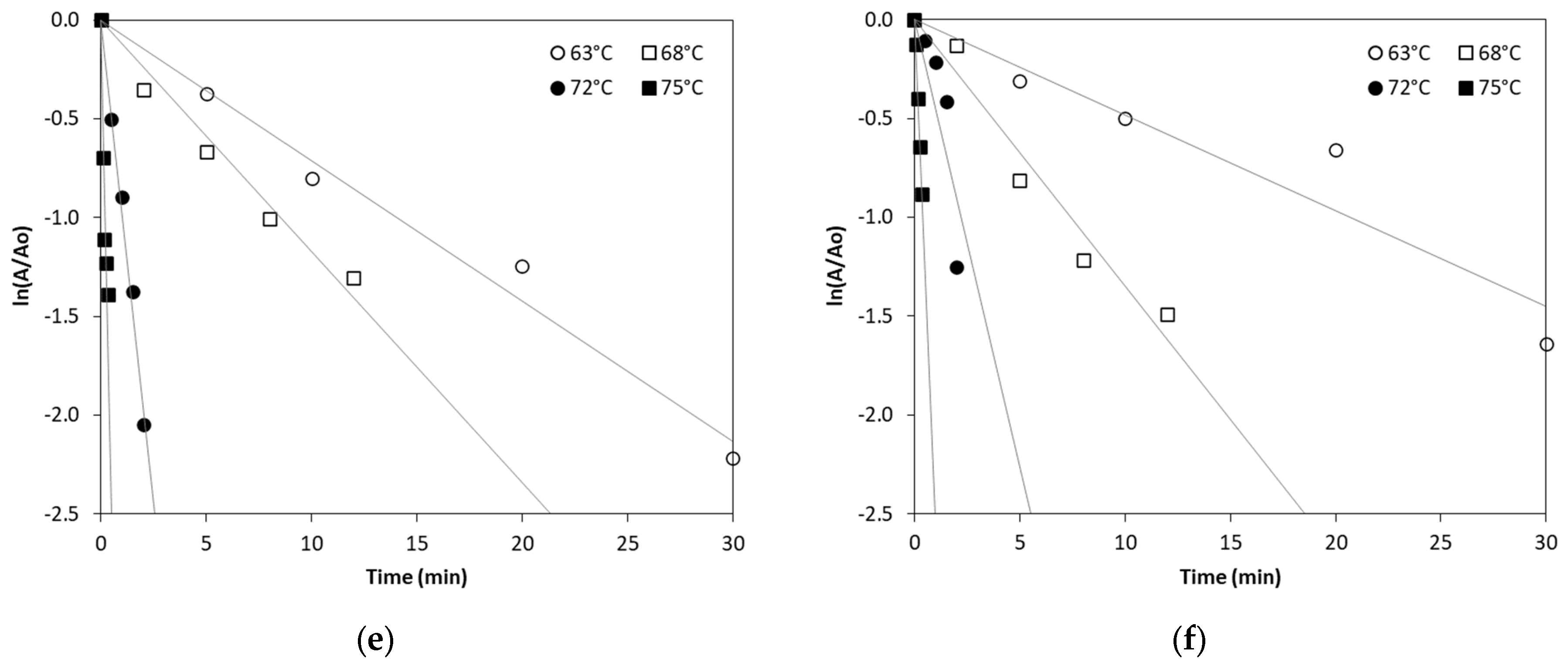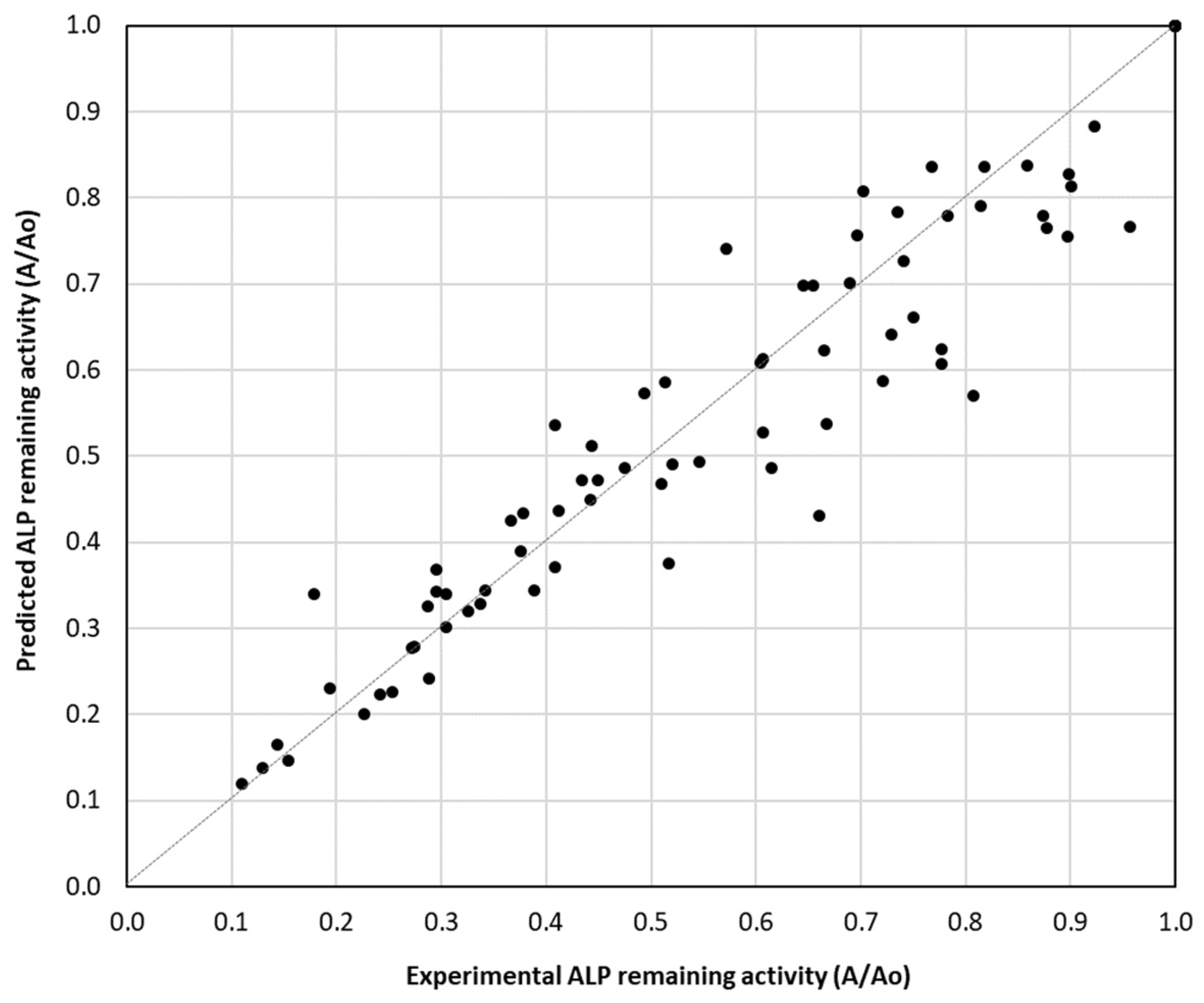A Comparative Kinetic Study on Alkaline Phosphatase Thermal Inactivation in Different Milk Types
Abstract
1. Introduction
2. Results and Discussion
3. Materials and Methods
3.1. Samples Collection and Treatment
3.2. Evaluation of Alkaline Phosphatase Enzyme Activity
3.3. Inactivation Kinetics and Data Analysis
3.4. Statistical Analysis
4. Conclusions
Author Contributions
Funding
Institutional Review Board Statement
Informed Consent Statement
Data Availability Statement
Acknowledgments
Conflicts of Interest
References
- Britt, J.H.; Cushman, R.A.; Dechow, C.D.; Dobson, H.; Humblot, P.; Hutjens, M.F.; Jones, G.A.; Ruegg, P.S.; Sheldon, I.M.; Stevenson, J.S. Invited review: Learning from the future—A vision for dairy farms and cows in 2067. J. Dairy Sci. 2018, 101, 3722–3741. [Google Scholar] [CrossRef] [PubMed]
- Faye, B.; Konuspayeva, G. The sustainability challenge to the dairy sector—The growing importance of non-cattle milk production worldwide. Int. Dairy J. 2012, 24, 50–56. [Google Scholar] [CrossRef]
- Clawin-Rädecker, I.; De Block, J.; Egger, L.; Willis, C.; Felicio, M.T.D.S.; Messens, W. The use of alkaline phosphatase and possible alternative testing to verify pasteurisation of raw milk, colostrum, dairy and colostrum-based products. EFSA J. 2021, 19, e06576. [Google Scholar] [CrossRef]
- Vasavada, P. Pathogenic Bacteria in Milk—A Review. J. Dairy Sci. 1988, 71, 2809–2816. [Google Scholar] [CrossRef]
- Deeth, H.C. Heat-induced inactivation of enzymes in milk and dairy products. A review. Int. Dairy J. 2021, 121, 105104. [Google Scholar] [CrossRef]
- Vimalraj, S. Alkaline phosphatase: Structure, expression and its function in bone mineralization. Gene 2020, 754, 144855. [Google Scholar] [CrossRef]
- Rankin, S.; Christiansen, A.; Lee, W.; Banavara, D.; Lopez-Hernandez, A. Invited review: The application of alkaline phosphatase assays for the validation of milk product pasteurization. J. Dairy Sci. 2010, 93, 5538–5551. [Google Scholar] [CrossRef]
- Tsiamita, A.; Valiakos, G.; Natsaridis, N.; Fotiadou, S.; Manouras, A.; Malissiova, E. Preliminary Results on the Comparative Evaluation of Alkaline Phosphatase Commercial Tests Efficiency in Non-Cow Milk Pasteurization. BioTech 2022, 11, 39. [Google Scholar] [CrossRef]
- Lorenzen, P.C.; Martin, D.; Clawin-Rädecker, I.; Barth, K.; Knappstein, K. Activities of alkaline phosphatase, γ-glutamyltransferase and lactoperoxidase in cow, sheep and goat’s milk in relation to heat treatment. Small Rumin. Res. 2010, 89, 18–23. [Google Scholar] [CrossRef]
- Marchand, S.; Merchiers, M.; Messens, W.; Coudijzer, K.; De Block, J. Thermal inactivation kinetics of alkaline phosphatase in equine milk. Int. Dairy J. 2009, 19, 763–767. [Google Scholar] [CrossRef]
- Raynal-Ljutovac, K.; Park, Y.; Gaucheron, F.; Bouhallab, S. Heat stability and enzymatic modifications of goat and sheep milk. Small Rumin. Res. 2007, 68, 207–220. [Google Scholar] [CrossRef]
- Malissiova, E.; Fotiadou, S.; Tzereme, A.; Cheimona, D.; Soultani, G.; Maisoglou, I.; Manouras, A. Alkaline Phosphatase (ALP) in Non-Cow Milk and Dairy Products: A Review of Current Evidence and Future Trends. Ruminants 2022, 2, 435–447. [Google Scholar] [CrossRef]
- Claeys, W.L.; VAN Loey, A.M.; Hendrickx, M.E. Kinetics of alkaline phosphatase and lactoperoxidase inactivation, and of β-lactoglobulin denaturation in milk with different fat content. J. Dairy Res. 2002, 69, 541–553. [Google Scholar] [CrossRef]
- Dumitraşcu, L.; Stănciuc, N.; Stanciu, S.; Râpeanu, G. Inactivation kinetics of alkaline phosphatase from different species of milk using quinolyl phosphate as a substrate. Food Sci. Biotechnol. 2014, 23, 1773–1778. [Google Scholar] [CrossRef]
- Claeys, W.L.; Ludikhuyze, L.R.; VAN Loey, A.M.; Hendrickx, M.E. Inactivation kinetics of alkaline phosphatase and lactoperoxidase, and denaturation kinetics of β-lactoglobulin in raw milk under isothermal and dynamic temperature conditions. J. Dairy Res. 2001, 68, 95–107. [Google Scholar] [CrossRef]
- Stănciuc, N.; Ardelean, A.; Diaconu, V.; Râpeanu, G.; Stanciu, S.; Nicolau, A. Kinetic and thermodynamic parameters of alkaline phosphatase and γ—Glutamyl transferase inactivation in bovine milk. Dairy Sci. Technol. 2011, 91, 701–717. [Google Scholar] [CrossRef]
- Wilińska, A.; Bryjak, J.; Illeová, V.; Polakovič, M. Kinetics of thermal inactivation of alkaline phosphatase in bovine and caprine milk and buffer. Int. Dairy J. 2007, 17, 579–586. [Google Scholar] [CrossRef]
- Lewis, M. Physical and physicochemical properties of milk and milk products. In Advanced Dairy Chemistry: Volume 3: Lactose, Water, Salts and Minor Constituents; Springer: Berlin/Heidelberg, Germany, 2022; pp. 493–551. [Google Scholar]
- Walstra, P.; Wouters, T.M.; Geurts, T.J. Dairy Science and Technology; CRC Press: Boca Raton, FL, USA, 2005. [Google Scholar]
- Mistry, V.V.; Ma, Y. Effect of homogenization pressure and fat content on the heat stability of milk. J. Dairy Sci. 1985, 68, 1850–1855. [Google Scholar]
- Datta, N.; Deeth, H.C. Heat treatment of milk: Effect on chemical and physical properties. Aust. J. Dairy Technol. 2001, 53, 181–189. [Google Scholar]
- De Kruif, C.; Holt, C. Casein micelle structure, functions and interactions. In Advanced Dairy Chemistry—1 Proteins: Part A/Part B; Springer: Berlin/Heidelberg, Germany, 2003; pp. 233–276. [Google Scholar]
- Anema, S.G.; McKenna, A.B. Effect of Milk Proteins on the Thermal Denaturation of Milk Enzymes. Int. Dairy J. 1996, 6, 407–422. [Google Scholar]
- Oldfield, D.J.; Singh, H.; Taylor, M.W. Association of β-lactoglobulin and β-lactalbumin with the casein micelles in skim milk heated in an ultra-high temperature plant. Int. Dairy J. 1998, 8, 765–770. [Google Scholar] [CrossRef]
- Havea, P. Protein interactions in milk protein concentrate powders. Int. Dairy J. 2006, 16, 415–422. [Google Scholar] [CrossRef]
- Levieux, D.; Geneix, N.; Levieux, A. Inactivation-denaturation kinetics of bovine milk alkaline phosphatase during mild heating as determined by using a monoclonal antibody-based immunoassay. J. Dairy Res. 2007, 74, 296–301. [Google Scholar] [CrossRef] [PubMed]
- Upadhyay, L.S.B.; Verma, N. A three step approach for the purification of alkaline phosphatase from non-pasteurized milk. J. Food Sci. Technol. 2014, 52, 3140–3146. [Google Scholar] [CrossRef]



| Temperature (°C) | Cow Milk | Sheep Milk | Goat Milk | Buffalo Milk | Donkey Milk | Camel Milk |
|---|---|---|---|---|---|---|
| 63 | 0.036 ± 0.003 c | 0.036 ± 0.006 b,c | 0.025 ± 0.006 d | 0.064 ± 0.003 a | 0.071 ± 0.006 a | 0.049 ± 0.009 b |
| 68 | 0.095 ± 0.005 b,c | 0.125 ± 0.019 a,b | 0.150 ± 0.013 a | 0.089 ± 0.007 c | 0.107 ± 0.009 b | 0.134 ± 0.017 a |
| 72 | 0.533 ± 0.082 b,c | 0.415 ± 0.079 c | 0.472 ± 0.076 b,c | 0.557 ± 0.058 b | 0.992 ± 0.055 a | 0.561 ± 0.169 b,c |
| 75 | 4.406 ± 0.111 b | 4.067 ± 0.481 b | 5.317 ± 0.235 a | 4.921 ± 0.422 a,b | 3.968 ± 0.842 b | 2.742 ± 0.165 c |
| Cow Milk | Sheep Milk | Goat Milk | Buffalo Milk | Donkey Milk | Camel Milk | |
|---|---|---|---|---|---|---|
| Ea (kJ/mol) | 380 ± 78 a | 363 ± 74 a | 410 ± 68 a | 344 ± 10 a | 336 ± 81 a | 320 ± 50 a |
| kref (min−1) | 0.372 ± 0.012 c | 0.362 ± 0.042 b,c | 0.393 ± 0.092 a,b,c | 0.430 ± 0.032 a,b | 0.504 ± 0.085 a | 0.381 ± 0.074 a,b,c |
| Dref (min) | 6.19 ± 0.20 a | 6.35 ± 0.65 a,b | 5.86 ± 1.11 a,b,c | 5.35 ± 0.36 b,c | 4.57 ± 0.66 c | 6.04 ± 0.98 a,b,c |
| z-value (°C) | 5.89 ± 1.30 a | 6.16 ± 1.78 a | 5.45 ± 1.65 a | 6.47 ± 1.14 a | 6.64 ± 1.58 a | 6.99 ± 1.87 a |
| Milk Type | Protein Content (%) | Fat Content (%) | Lactose Content (%) | Non-Fat Milk Solids (%) |
|---|---|---|---|---|
| Cow milk | 3.2 | 3.9 | 4.8 | 8.9 |
| Sheep milk | 5.6 | 6.9 | 4.7 | 11.3 |
| Goat milk | 3.6 | 4.5 | 4.2 | 8.8 |
| Buffalo milk | 5.0 | 8.5 | 4.8 | 9.7 |
| Donkey milk | 2.2 | 1.2 | 7.2 | 9.5 |
| Camel milk | 3.4 | 3.1 | 5.1 | 8.6 |
Disclaimer/Publisher’s Note: The statements, opinions and data contained in all publications are solely those of the individual author(s) and contributor(s) and not of MDPI and/or the editor(s). MDPI and/or the editor(s) disclaim responsibility for any injury to people or property resulting from any ideas, methods, instructions or products referred to in the content. |
© 2025 by the authors. Licensee MDPI, Basel, Switzerland. This article is an open access article distributed under the terms and conditions of the Creative Commons Attribution (CC BY) license (https://creativecommons.org/licenses/by/4.0/).
Share and Cite
Tzereme, A.; Koureas, M.; Manouras, A.; Malissiova, E.; Soultani, G.; Poulianiti, K.; Gogou, E. A Comparative Kinetic Study on Alkaline Phosphatase Thermal Inactivation in Different Milk Types. Kinases Phosphatases 2025, 3, 11. https://doi.org/10.3390/kinasesphosphatases3020011
Tzereme A, Koureas M, Manouras A, Malissiova E, Soultani G, Poulianiti K, Gogou E. A Comparative Kinetic Study on Alkaline Phosphatase Thermal Inactivation in Different Milk Types. Kinases and Phosphatases. 2025; 3(2):11. https://doi.org/10.3390/kinasesphosphatases3020011
Chicago/Turabian StyleTzereme, Anastasia, Michalis Koureas, Athanasios Manouras, Eleni Malissiova, Georgia Soultani, Konstantina Poulianiti, and Eleni Gogou. 2025. "A Comparative Kinetic Study on Alkaline Phosphatase Thermal Inactivation in Different Milk Types" Kinases and Phosphatases 3, no. 2: 11. https://doi.org/10.3390/kinasesphosphatases3020011
APA StyleTzereme, A., Koureas, M., Manouras, A., Malissiova, E., Soultani, G., Poulianiti, K., & Gogou, E. (2025). A Comparative Kinetic Study on Alkaline Phosphatase Thermal Inactivation in Different Milk Types. Kinases and Phosphatases, 3(2), 11. https://doi.org/10.3390/kinasesphosphatases3020011






